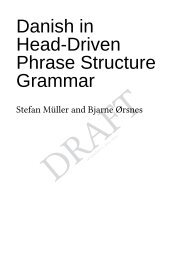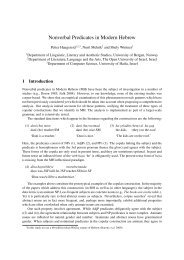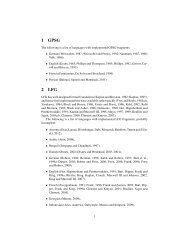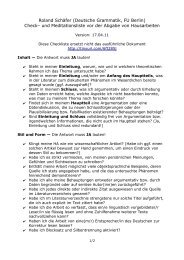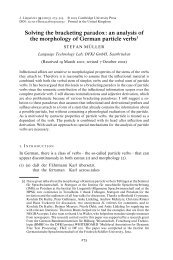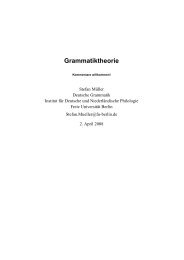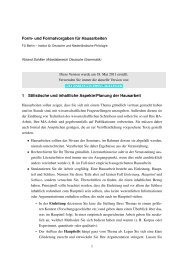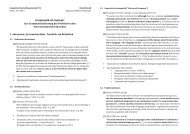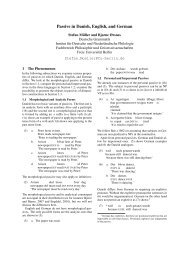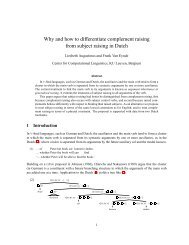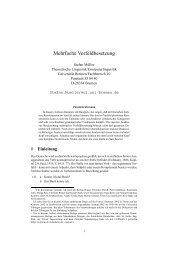Grammatiktheorie - German Grammar Group FU Berlin - Freie ...
Grammatiktheorie - German Grammar Group FU Berlin - Freie ...
Grammatiktheorie - German Grammar Group FU Berlin - Freie ...
Erfolgreiche ePaper selbst erstellen
Machen Sie aus Ihren PDF Publikationen ein blätterbares Flipbook mit unserer einzigartigen Google optimierten e-Paper Software.
452 Literaturverzeichnis<br />
putational Linguistics. Proceedings of the Conference. <strong>Berlin</strong>: Association for Computational<br />
Linguistics, 21–26. http://www.aclweb.org/anthology/E91-1005.pdf, 21.03.2008.<br />
Beghelli, Filippo und Timothy Stowell (1997), „Distributivity and Negation: The Syntax of each and<br />
every“, in: A. Szabolcsi, Hg., Ways of Scope Taking. Dordrecht/Boston/London: Kluwer Academic<br />
Publishers, 71–107.<br />
Behaghel, Otto (1909), „Beziehung zwischen Umfang und Reihenfolge von Satzgliedern“, Indogermanische<br />
Forschungen, 25, 110–142.<br />
Behaghel, Otto (1930), „Von deutscher Wortstellung“, Zeitschrift für Deutschkunde, 44, 81–89.<br />
Behrens, Heike (2009), „Konstruktionen im Spracherwerb“, Zeitschrift für <strong>German</strong>istische Linguistik,<br />
37(3), 427––444.<br />
Bellugi, Ursula, Liz Lichtenberger, Wendy Jones, Zona Lai und Marie St. George (2000), „The<br />
Neurocognitive Profile of Williams Syndrome: A Complex Pattern of Strengths and Weaknesses“,<br />
Journal of Cognitive Neuroscience, 12(Supplement), 7–29.<br />
Bender, Emily und Daniel P. Flickinger (1999), „Peripheral Constructions and Core Phenomena:<br />
Agreement in Tag Questions“, in Webelhuth et al. (1999), 199–214.<br />
Bender, Emily M. (2002), Syntactic Variation and Linguistic Competence: The Case of AAVE Copula<br />
Absence. PhD thesis, Stanford University. http://faculty.washington.edu/ebender/dissertation/,<br />
21.05.2004.<br />
Bender, Emily M. (2008a), „Evaluating a Crosslinguistic <strong>Grammar</strong> Resource: A Case Study of Wambaya“,<br />
in Moore et al. (2008), 977–985. http://aclweb.org/anthology-new/P/P08/P08-1111.pdf,<br />
08.02.2010.<br />
Bender, Emily M. (2008b), „<strong>Grammar</strong> Engineering for Linguistic Hypothesis Testing“, in:<br />
N. Gaylord, A. Palmer und E. Ponvert, Hgg., Proceedings of the Texas Linguistics Society X Conference:<br />
Computational Linguistics for Less-Studied Languages. Stanford CA: CSLI Publications<br />
ONLINE, 16–36.<br />
Bender, Emily M. (2008c), „Radical Non-Configurationality without Shuffle Operators: An Analysis<br />
of Wambaya“, in: St. Müller, Hg., Proceedings of the 15th International Conference on Head-<br />
Driven Phrase Structure <strong>Grammar</strong>, NICT, Keihanna, Japan. Stanford, CA: CSLI Publications,<br />
6–24. http://cslipublications.stanford.edu/HPSG/9/, 31.10.2008.<br />
Bender, Emily M. (2010), „Reweaving a <strong>Grammar</strong> for Wambaya: A Case Study in <strong>Grammar</strong> Engineering<br />
for Linguistic Hypothesis Testing“, Linguistic Issues in Language Technology — LiLT,<br />
3(3), 1–34. http://elanguage.net/journals/index.php/lilt/article/view/662, 30.03.2010.<br />
Bender, Emily M., Dan Flickinger, Frederik Fouvry und Melanie Siegel, Hgg. (2003), Proceedings<br />
of the ESSLLI 2003 Workshop “Ideas and Strategies for Multilingual <strong>Grammar</strong> Development”.<br />
Vienna, Austria.<br />
Bender, Emily M., Daniel P. Flickinger und Stephan Oepen (2002), „The <strong>Grammar</strong> Matrix: An<br />
Open-Source Starter-Kit for the Rapid Development of Cross-Linguistically Consistent Broad-<br />
Coverage Precision <strong>Grammar</strong>s“, in: J. Carroll, N. Oostdijk und R. Sutcliffe, Hgg., Proceedings of<br />
the Workshop on <strong>Grammar</strong> Engineering and Evaluation at the 19th International Conference on<br />
Computational Linguistics. Taipei, Taiwan, 8–14.<br />
Bender, Emily M. und Melanie Siegel (2005), „Implementing the Syntax of Japanese Numeral<br />
Classifiers“, in Su et al. (2005), 626–635. http://www.melaniesiegel.de/publications/<br />
syntax-of-numeral-classifiers.pdf, 31.05.2010.<br />
Bergen, Benjamin K. und Nancy Chang (2005), „Embodied Construction <strong>Grammar</strong> in Simulation-<br />
Based Language Understanding“, in: J.-O. Östman und M. Fried, Hgg., Construction <strong>Grammar</strong>s:<br />
Cognitive Grounding and Theoretical Extensions. Amsterdam and Philadelphia: John Benjamins<br />
Publishing Co., 147–190.<br />
Berman, Judith (1996), „Eine LFG-Grammatik des Deutschen“, in Berman und Frank (1996), 11–<br />
96.<br />
Literaturverzeichnis 453<br />
Berman, Judith (1999), „Does <strong>German</strong> Satisfy the Subject Condition?“, in Butt und King (1999).<br />
http://csli-publications.stanford.edu/LFG/4/, 24.11.1999.<br />
Berman, Judith (2003a), Clausal Syntax of <strong>German</strong>, Stanford, CA: CSLI Publications, [Studies in<br />
Constraint-Based Lexicalism].<br />
Berman, Judith (2003b), „Zum Einfluss der strukturellen Position auf die syntaktische Funktion der<br />
Komplementsätze“, Deutsche Sprache, 3, 263–286.<br />
Berman, Judith (2007), „Functional Identification of Complement Clauses in <strong>German</strong> and the<br />
Specification of COMP“, in: A. Zaenen, J. Simpson, T. H. King, J. Grimshaw, J. Maling und<br />
C. Manning, Hgg., Architectures, Rules, and Preferences. Variations on Themes by Joan W. Bresnan.<br />
Stanford, CA: CSLI Publications.<br />
Berman, Judith und Anette Frank (1996), Deutsche und französische Syntax im Formalismus der<br />
LFG, Tübingen: Max Niemeyer Verlag, [Linguistische Arbeiten 344].<br />
Berwick, Robert C. (1982), „Computational Complexity and Lexical-Functional <strong>Grammar</strong>“, American<br />
Journal of Computational Linguistics, 8(3–4), 97–109.<br />
Berwick, Robert C. und Partha Niyogi (1996), „Learning from Triggers“, Linguistic Inquiry,<br />
27, 605–622.<br />
Bickerton, Derek (1984a), „Creol is Still King“, The Behavioral and Brain Sciences, 7(2), 212–218.<br />
Bickerton, Derek (1984b), „The Language Bioprogram Hypothesis“, The Behavioral and Brain<br />
Sciences, 7(2), 173–188.<br />
Bickerton, Derek (1997), „How to Acquire Language without Positive Evidence: What Acquisitionists<br />
Can Learn from Creoles“, in: M. DeGraff, Hg., Language Creation and Language Change:<br />
Creolization, Diachrony, and Development. Cambridge, MA: MIT Press, 49–74, [Learning, Development,<br />
and Conceptual Change].<br />
Bierwisch, Manfred (1963), Grammatik des deutschen Verbs, <strong>Berlin</strong>: Akademie Verlag, [studia<br />
grammatica II].<br />
Bierwisch, Manfred (1992), „Grammatikforschung in der DDR: Auch ein Rückblick“, Linguistische<br />
Berichte, 139, 169–181.<br />
Bildhauer, Felix (2008), Representing Information Structure in an HPSG <strong>Grammar</strong> of Spanish. PhD<br />
thesis, Universität Bremen.<br />
Bird, Steven und Ewan Klein (1994), „Phonological Analysis in Typed Feature Systems“, Computational<br />
Linguistics, 20(3), 455–491. http://www.hcrc.ed.ac.uk/~ewan/Papers/, 06.01.2006.<br />
Bishop, Dorothy V.M. (2002), „Putting language genes in perspective“, TRENDS in Genetics, 18(2).<br />
Blackburn, Patrick, Claire Gardent und Wilfried Meyer-Viol (1993), „Talking about Trees“, in Krauwer<br />
et al. (1993), 21–29.<br />
Blackburn, Patrick und Johan Bos (2005), Representation and Inference for Natural Language. A<br />
First Course in Computational Semantics, Stanford, CA: CSLI Publications.<br />
Błaszczak, Joanna und Hans-Martin Gärtner (2005), „Intonational Phrasing, Discontinuity, and the<br />
Scope of Negation“, Syntax, 8(1), 1–22.<br />
Block, Hans-Ulrich und Rudolf Hunze (1986), „Incremental Construction of C- and F-Structure in<br />
a LFG-Parser“, in Nagao (1986), 490–493.<br />
Bloom, Paul (1993), „Grammatical Continuity in Language Development: The Case of Subjectless<br />
Sentences“, Linguistic Inquiry, 24(4), 721–734.<br />
Bobaljik, Jonathan (1999), „Adverbs: The Hierarchy Paradox“, Glot International, 4(9/10), 27–28.<br />
Bod, Rens (2009a), „Constructions at Work or at Rest?“, Cognitive Linguistics, 20(1), 129–134.<br />
Bod, Rens (2009b), „From Exemplar to <strong>Grammar</strong>: Integrating Analogy and Probability in Language<br />
Learning“, Cognitive Science, 33(4), 752–793. http://staff.science.uva.nl/~rens/analogy.pdf,<br />
15.07.2008.<br />
Bögel, Tina, Miriam Butt und Sebastian Sulger (2008), „Urdu Ezafe and the Morphology-Syntax<br />
Interface“, in Butt und King (2008), 129–149. http://cslipublications.stanford.edu/LFG/13/lfg08.<br />
html, 23.01.2009.




